 Soviet Military Power
Soviet Military Power Soviet Military Power
Soviet Military Power
 Despite public avowals that nuclear war is unwinnable and that strategic arms arsenals must be dismantled, the Soviets continue deploying new generations of intercontinental ballistic missiles, submarine-launched ballistic missiles, and manned strategic bombers. These new, far more capable strategic nuclear systems include:
Despite public avowals that nuclear war is unwinnable and that strategic arms arsenals must be dismantled, the Soviets continue deploying new generations of intercontinental ballistic missiles, submarine-launched ballistic missiles, and manned strategic bombers. These new, far more capable strategic nuclear systems include:
- The highly accurate SS-18 Mod 5 ICBM, the road mobile SS-25 ICBM, and the rail-mobile and silo launched SS-24 ICBM;
- The Typhoon-class strategic ballistic missile submarine with SS-N-20 SLBMs, and Delta IV-class SSBN with SS-N-23 SLBMs;
- The Blackjack and Bear H manned strategic bombers armed with 3,000-kilometer-range, air-launched cruise missiles; and
- Converted Yankee-class and other submarine platforms carrying sea-launched strategic land-attack
cruise missiles.
Furthermore, Soviet plans for the employment of strategic nuclear weapons appear thus far to have changed little despite their claim to have adopted a defensive doctrine. These plans remain driven by two basic assessments: first, that the use of strategic nuclear weapons will most likely result from an escalation of battlefield nuclear weapon employment in Europe; and second, that the best way to limit damage in a strategic nuclear war is to initiate the attack.
Under their announced defensive doctrine, the Soviets appear to be continuing to seek a European theater posture relative to NATO that results in NATO being less likely to employ strategic nuclear weapons as provided strategic doctrine of flexible response. Thus one of their goals in signing the INF Treaty appears to have been the elimination of some nuclear weapons that, although designated for use in the European theater, could allow a battlefield nuclear exchange to spill over to the Soviet homeland. For the same reason, they also are continuing to seek the elimination of all short-range nuclear weapons in Europe as evidenced by Gorbachev's recent proposal to unilaterally cut short-range nuclear forces (SNF) in exchange for a US agreement to discuss SNF cuts.
By attempting to create conditions where a war between the alliances is restricted to Europe, the Soviets are increasing their emphasis on the deterrent aspect of their strategic offensive and defensive programs. This shift of focus, however, has not brought reductions in their nuclear weapon programs other than as a result of the INF Treaty. Indeed, while the Soviets recognize the deterring aspects of their nuclear forces, the basic tenet of their strategic nuclear doctrine is to have a strategic war fighting capability that can inflict a devastating nuclear strike against an adversary under all circumstances. Moreover, despite their announced defensive doctrine,the Soviets' preferred nuclear employment option, in circumstances in which the likelihood of enemy strategic nuclear weapon employment is considered high, remains a preemptive attack. This attack option involves launching Soviet nuclear weapons once convincing evidence has been received that an adversary is preparing to launch a nuclear attack against the Soviet Union. Although the Soviets argue that preemption is merely self-defense against an imminent attack, it is primarily designed to achieve strategic war fighting objectives and involves the Soviets launching their strategic missiles first.
The Soviets continue to develop and deploy strategic offensive forces based on force requirement decisions made ten to twenty years ago, and the general pace of this modernization has not been affected by the ongoing national security policy debates under Gorbachev. It remains to be seen how these debates will affect the future force structure. Systems being deployed today are increasingly accurate and survivable. Improved survivability is particularly evident in the deployment of the rail-mobile SS-24 and the road-mobile SS-25 ICBMs. The mobile systems enhance both the deterrent and war fighting capabilities of Soviet strategic offensive forces by increasing the likelihood that Soviet strategic nuclear weapons will be available for follow-on attacks after an initial exchange.
The Soviets have made START proposals to reduce the number of strategic nuclear systems available to both the Soviet Union and the United States. These proposals, however, do not in themselves confirm a change in Soviet employment policy, nor do they affect the Soviet capability to achieve its nuclear war fighting objectives.
Soviet strategic nuclear forces consist of the land-based ballistic missiles and launchers of the Strategic Rocket Forces (SRF), the navy's ballistic missile and strategic land-attack cruise-missile submarines, and long-range aviation's intercontinental and medium range bombers carrying air-launched cruise missiles and bombs. Historically, the Soviets have always favored the ballistic missile as a nuclear delivery system, and the bulk of Soviet nuclear weapons are mounted on SRF ballistic missiles. The Soviet SSBN force, however, has grown in the last twenty years, both in numbers of deliverable weapons and in SSBN and weapon capabilities. Soviet strategic aviation has received new systems with improved capabilities in the 1980s, but still remains a comparatively small portion of the Soviet strategic nuclear forces.
The Soviets combine the actions of these forces into an integrated, national-level plan for strategic force employment in wartime. In the event of war, the General Headquarters (or Stavka) of the Soviet Supreme High Command (VGK) would directly control the strategic nuclear forces through the General Staffs Main Operations Directorate. As General Secretary of the Communist Party and Supreme Commander-in-Chief of the Armed Forces, Gorbachev chairs the Defense Council and would head the Soviet Supreme High Command General Headquarters, the highest wartime military body. The order authorizing nuclear weapon employment would be passed from the VGK Stavka to the General Staff for implementation via its command, control, and communications system for the strategic nuclear forces. There are no indications that this organization or these command procedures are undergoing any changes.
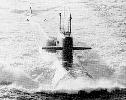 Over a 40-year period the Soviets, through their wartime leadership continuity program, have made extensive, sustained investments in the direct protection of their top political leadership and key military command authorities. The program's intent is to ensure the survival and effective command function of these critical leadership elements under the full range of nuclear conflict contingencies, including protracted nuclear war. The Soviet program has resulted in the construction of highly survivable, readily accessible deep-underground command post facilities; the development of redundant communications systems and networks; and the deployment of an array of ground-mobile, trainborne, and airborne command platforms.
Over a 40-year period the Soviets, through their wartime leadership continuity program, have made extensive, sustained investments in the direct protection of their top political leadership and key military command authorities. The program's intent is to ensure the survival and effective command function of these critical leadership elements under the full range of nuclear conflict contingencies, including protracted nuclear war. The Soviet program has resulted in the construction of highly survivable, readily accessible deep-underground command post facilities; the development of redundant communications systems and networks; and the deployment of an array of ground-mobile, trainborne, and airborne command platforms.
The Soviets have created and deployed a nuclear force structure designed to operate in a variety of nuclear exchange environments and still accomplish its mission of destroying a wide spectrum of enemy nuclear forces, military forces, and political and economic targets. They also have created a sophisticated intelligence organization that is adept at combining a wide variety of overt and covert collection and processing means to monitor strategic indicators. Should intelligence predict an imminent nuclear attack, the Soviets would likely try to preempt an enemy strike with a massive strategic nuclear strike of their own. They may see such an employment option as even more critical if a future environment arises in which there are fewer strategic weapons to conduct strategic tasks. In this case, significant losses in its strategic forces may preclude Moscow from accomplishing critical war fighting missions.
In the event the Soviets fail to execute their preemptive option, they may have to launch while under attack. To deal with this contingency, they have established a complex system of launch detection satellites, over the-horizon radars, and USSR-based large phased-array radars that will provide the Soviet high command with up to 30 minutes warning of an incoming attack. These systems are able to determine the general direction of the attack and conduct missile tracking.
Soviet military theorists have traditionally held that once an attack has been launched, a period of protracted nuclear operations would likely follow. To facilitate such operations, the Soviets have taken the following preparatory measures:
- Their nuclear force command and control system has been designed for maximum survivability. It combines hardened command posts and ground and air-mobile command post and communications assets.
- They have constructed extremely hardened silos and deployed increasing numbers of road- and rail-mobile launchers in the Strategic Rocket Forces; dispersed airfields for Long-Range Aviation; and dispersed basing and logistical sites for SSBNs to enhance nuclear force survivability.
- They are planning for their strategic forces to have a reload and refire capability.
Even as Gorbachev pushes for strategic arms negotiations, the Soviet Union continues to pursue the complete modernization of its ICBM arsenal. The latest round of modifications will provide the Soviets with a more lethal ICBM attack force. In some areas the Soviets are constructing new facilities, or renovating existing ones, for the purpose of expanding the mobile ICBM force. In other areas they are converting silos to house newer, more effective missiles that will enhance the fixed ICBM force.
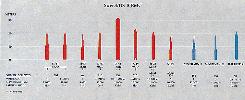 The most significant current improvements to the SRF's ICBM force include greater accuracy, greater mobility, and a consolidated force in which seven unique missile systems will be reduced to just three classes of systems. However, in the absence of a START treaty, ICBM warheads are expected to increase as systems with greater reentry vehicle (RV) capacities come online. The Soviets will likely maintain adequate weapons even under START constraints to cover current and anticipated future target sets. Silo conversion activity to
replace the current variant of the SS-18 Satan which is the bulwark of the SRF's hard-target-kill capability with a newer, more accurate version (the SS-18 Mod 5) is under way. The increase in the Mod 5's warhead yield, along with improved accuracy, would, under a START treaty, help allow the Soviets to maintain their hard-target-kill wartime requirements even with the 50 percent cut in heavy ICBMs START requires.
The most significant current improvements to the SRF's ICBM force include greater accuracy, greater mobility, and a consolidated force in which seven unique missile systems will be reduced to just three classes of systems. However, in the absence of a START treaty, ICBM warheads are expected to increase as systems with greater reentry vehicle (RV) capacities come online. The Soviets will likely maintain adequate weapons even under START constraints to cover current and anticipated future target sets. Silo conversion activity to
replace the current variant of the SS-18 Satan which is the bulwark of the SRF's hard-target-kill capability with a newer, more accurate version (the SS-18 Mod 5) is under way. The increase in the Mod 5's warhead yield, along with improved accuracy, would, under a START treaty, help allow the Soviets to maintain their hard-target-kill wartime requirements even with the 50 percent cut in heavy ICBMs START requires.
The deployment of both the road-mobile SS-25 in 1985 and the rail-mobile SS-24 Mod I in 1987 has significantly enhanced Soviet ICBM force survivability through these missile systems' dispersal and concealment capabilities. As the Soviets field more of these mobile systems, they are removing older missile systems, such as the SS-11 and the SS-17. Additionally, they are removing the SS-19 Stiletto from the SRF operational inventory and replacing it with a silo-deployed version of the SS-24. Conversion of selected SS-19 silos to SS-24 Mod 2 silos is currently under way, and some converted silos already house operational Mod 2 missiles. The dual-mode basing of the SS-24 provides a force mix of fixed and mobile ICBMs that meets Soviet requirements for survivability, responsiveness, and accuracy. Within several years the mobile SS-24 and SS-25 may comprise nearly 50 percent of the Soviet ICBM force.
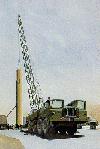 This current series of modifications may take several years to complete and may face limitations under a START agreement. Nevertheless, the Soviet ICBM modernization program could be easily adapted to potential limits imposed by a START treaty. The Soviets probably will not allow strategic arms limitations to jeopardize their continued ability to meet targeting, survivability, and force responsiveness goals. The thrust of the program is clear: the Soviets are attempting to
deploy an ICBM force that is capable of satisfying their wartime objectives with fewer, significantly more survivable missile systems.
This current series of modifications may take several years to complete and may face limitations under a START agreement. Nevertheless, the Soviet ICBM modernization program could be easily adapted to potential limits imposed by a START treaty. The Soviets probably will not allow strategic arms limitations to jeopardize their continued ability to meet targeting, survivability, and force responsiveness goals. The thrust of the program is clear: the Soviets are attempting to
deploy an ICBM force that is capable of satisfying their wartime objectives with fewer, significantly more survivable missile systems.
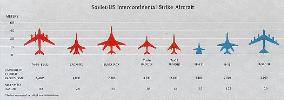 During the past decade, Soviet intercontinental bomber force modernization enhanced what had been the least effective element of the Soviet strategic triad. New aircraft and weapon systems, particularly the Bear H and Blackjack aircraft and the AS-15 long-range air-launched cruise missile (ALCM), represent a major effort to increase the bomber force's weapons delivery capability and improve its survivability to accomplish intercontinental nuclear strike missions.
During the past decade, Soviet intercontinental bomber force modernization enhanced what had been the least effective element of the Soviet strategic triad. New aircraft and weapon systems, particularly the Bear H and Blackjack aircraft and the AS-15 long-range air-launched cruise missile (ALCM), represent a major effort to increase the bomber force's weapons delivery capability and improve its survivability to accomplish intercontinental nuclear strike missions.
The primary component of the intercontinental bomber force consists of Bear H AS-15 ALCM carriers. Prior to the Bear's introduction, older Soviet bombers(such as the Bison and older model Bears) had to penetrate Canadian or US airspace to launch their attacks. As recently as 1983, most of the intercontinental bomber force's air-delivered weapons were free-fall bombs. Today, the majority of the current strategic air-delivered weapons inventory comprises AS-15s that have a stand-off range of 3,000 kilometers. While Bear G and remaining older bombers could augment Bear H strike missions, their shorter-range weapons would make them vulnerable to North American air defenses. Midas and Bison tankers provide in-flight refueling support.
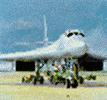 The Soviets' newest intercontinental bomber, the Blackjack, entered the operational inventory in 1988. Over 15 have been produced, and the first operational unit has begun forming at an airfield near Moscow. The world's largest and heaviest bomber, the Blackjack, is designed to carry either 12 AS-15s or 24 of the new AS-16 short-range attack missiles. The Blackjack can cruise subsonically over long distances, perform high altitude supersonic dash, and attack using low-altitude,high-subsonic penetration maneuvers.
The Soviets' newest intercontinental bomber, the Blackjack, entered the operational inventory in 1988. Over 15 have been produced, and the first operational unit has begun forming at an airfield near Moscow. The world's largest and heaviest bomber, the Blackjack, is designed to carry either 12 AS-15s or 24 of the new AS-16 short-range attack missiles. The Blackjack can cruise subsonically over long distances, perform high altitude supersonic dash, and attack using low-altitude,high-subsonic penetration maneuvers.
While the total number of Long-Range Aviation aircraft has remained relatively constant, the quality of deployed aircraft and the force weapons delivery capability has dramatically increased. The trend of the past decade has clearly been toward modernization and increased strategic strike capability. There is no current evidence to indicate a reversal of this trend.
 The Soviet Navy continues modernizing its strategic missile submarine force, even as it retires older systems. A sixth Delta IV SSBN put to sea in 1989 and a sixth Typhoon-class SSBN launched in early 1989 are expected to join the operational force later in the year. The Soviets also deployed a modified version
of the Delta IV's SS-N-23 missile in 1988, and a
modified version of the Typhoon's SS-N-20 missile may
begin testing soon. Both programs are geared toward
improving the accuracy and increasing the warhead
yield of these systems in
The Soviet Navy continues modernizing its strategic missile submarine force, even as it retires older systems. A sixth Delta IV SSBN put to sea in 1989 and a sixth Typhoon-class SSBN launched in early 1989 are expected to join the operational force later in the year. The Soviets also deployed a modified version
of the Delta IV's SS-N-23 missile in 1988, and a
modified version of the Typhoon's SS-N-20 missile may
begin testing soon. Both programs are geared toward
improving the accuracy and increasing the warhead
yield of these systems in 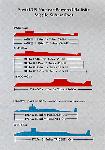 order to develop an SLBM
hard-target-kill capability. Furthermore, the increased
range of current SS-N-20 and SS-N-23 SLBMs allows
Soviet SSBN patrols to remain close to or within USSR
home waters, thus enhancing the survivability of their
naval strategic assets.
order to develop an SLBM
hard-target-kill capability. Furthermore, the increased
range of current SS-N-20 and SS-N-23 SLBMs allows
Soviet SSBN patrols to remain close to or within USSR
home waters, thus enhancing the survivability of their
naval strategic assets.
The Soviets also have established an elaborate protection scheme whereby naval, air, and shore assets, in conjunction with the natural Arctic ice zone, protect SSBN bastion areas against US/NATO antisubmarine forces. Utilizing these combined arms assets, the Soviets hope to reduce significantly the vulnerability of their SSBNs.
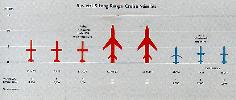 The Soviet Union has two versions of an operational long-range land-attack cruise missile: the SS
N-21 SLCM and the AS-15 ALCM. Both missiles
give their respective launching platforms the ability to
attack most North American and Eurasian targets. The
SS-N-21 can probably be launched from any modern
nuclear-powered class submarine. Specific candidates
for employment are Yankee Notch-, Akula-, and Victor-
class SSNs. The AS-15 is operationally deployed on
Bear H and Blackjack intercontinental bombers. A new
air-launched long-range cruise missile, the AS-X-19, is
under development and when operational in the early
1990s could be deployed on the Bear H aircraft. Test
activity for a sea-launched version, the SS-NX-24, is
continuing at a slow pace.
The Soviet Union has two versions of an operational long-range land-attack cruise missile: the SS
N-21 SLCM and the AS-15 ALCM. Both missiles
give their respective launching platforms the ability to
attack most North American and Eurasian targets. The
SS-N-21 can probably be launched from any modern
nuclear-powered class submarine. Specific candidates
for employment are Yankee Notch-, Akula-, and Victor-
class SSNs. The AS-15 is operationally deployed on
Bear H and Blackjack intercontinental bombers. A new
air-launched long-range cruise missile, the AS-X-19, is
under development and when operational in the early
1990s could be deployed on the Bear H aircraft. Test
activity for a sea-launched version, the SS-NX-24, is
continuing at a slow pace.
As stated earlier, Soviet attempts to create conditions where a war between the alliances is restricted to Europe emphasize the deterrent aspects of their strategic offensive and defensive programs, but have not brought about reductions in these programs. Moreover, there is as yet no indication the Soviets will abandon their preferred strategic weapon employment policy of preemption and adopt the more defensive policy of retaliation.
A wide variety of issues including, but not limited to, arms control developments, the possible deployment of a US strategic defense system, and the potential for advances in future strategic weapons technology, will influence the Soviet leadership as it shapes the future Soviet strategic nuclear arsenal. Examples include:
- START: It would be possible for the Soviets to sign a START treaty as currently envisioned and essentially retain the capability to conduct strikes against critical nuclear, other military, and political and economic targets. This capability would result from several factors, including a possible reduction in the number of US hardened targets the Soviets would have to attack; the improved capabilities of new Soviet nuclear systems such as the SS-18 Mod 5 (which potentially reduces the number of warheads that would be assigned to each target); and the improved survivability of new Soviet strategic systems. - SDI: Because US deployment of a strategic defense system with even limited effectiveness would seriously complicate Soviet strategic strike planning, such a US decision could lead the Soviets to reassess the effectiveness of their strategic war plans, and possibly modify their arms control proposals. According to Soviet statements, their response would involve both quantitative and qualitative measures. For example, at the extreme, the Soviets may deploy greater numbers of nuclear warheads as a means to saturate and overwhelm US defensive systems. Additionally, what the Soviets term "active measures," such as antisatellite weapons, and "passive measures," such as decoys and other penetration aids, could be deployed in an attempt to ensure the survivability of Soviet strategic forces conducting nuclear strikes.
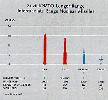 The Soviets' intermediate-range nuclear systems the road-transportable SS-4 Sandal MRBM and road mobile SS-20 Saber IRBM are currently integral components of the Soviet strategic nuclear forces. These systems have the capability to attack all European soft point or area targets.
The Soviets' intermediate-range nuclear systems the road-transportable SS-4 Sandal MRBM and road mobile SS-20 Saber IRBM are currently integral components of the Soviet strategic nuclear forces. These systems have the capability to attack all European soft point or area targets.
The SS-20 and the SS-4 are among the missile systems being eliminated under the terms of the INF Treaty. The treaty, which became effective in June 1988, calls for both countries to eliminate over a three-year period all ground-launched nuclear force missiles (including cruise missiles) in the 500-5,500 kilometer range. The treaty also affects two shorter-range ballistic missile systems, the SS-12 and the SS-23; these systems are discussed in the Short-Range Nuclear Forces section of this chapter.
The Soviets began eliminating INF Treaty-related missiles and launchers in July 1988. Prior to the INF drawdown, the SS-20 force comprised 48 bases that housed the regularly deployed force of 405 missiles and launchers. The SS-4 force consisted of 96 prepared launch positions supporting 60 deployed missiles.
Before negotiating the dismantlement of their SS-20 force, a system they developed in the early 1970s and began deploying in 1977, the Soviets weighed its value against the capabilities of US/NATO intermediate-range systems, and considered what systems were immediately available to compensate each side for its loss. Based on Soviet targeting goals and nuclear strike force missions in Eurasia, it is likely that the Soviets determined they could compensate for the elimination of INF forces by retargeting other strategic and tactical nuclear delivery systems. Many of the SS-20's targets can be covered by ICBMs and SLBMs supplemented by aviation assets. The SS-11 and SS-19 ICBMs, as well as all SLBMs deployed in Soviet-protected bastions, will provide target coverage through the mid-199Os, with SS-24s and SS-25s potentially available as well. Even after INF and START treaty reductions, the Soviets will likely be able to satisfy their critical tactical, theater, and intercontinental targeting requirements as effectively as with their current arsenal due to the ongoing modernization of their strategic forces. The Soviets also recognize that the INF Treaty has caused some dissension within the NATO Alliance.
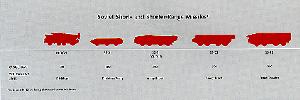 The Soviet military also deploys a wide variety of nuclear delivery systems with a range of less than 1,000 kilometers. These include shorter-range intermediate range nuclear forces (SRINF) missiles, which are covered by the INF Treaty. Specifically, the SS-12 and SS-23 are currently being eliminated. The INF Treaty does not cover short-range nuclear missiles with a range of less than 500 kilometers, dual-capable aircraft, and artillery pieces. Thus, while the INF Treaty eliminates the most threatening Soviet nuclear systems, the Soviets will retain a more than adequate capability to provide tactical nuclear support for their ground forces.
The Soviet military also deploys a wide variety of nuclear delivery systems with a range of less than 1,000 kilometers. These include shorter-range intermediate range nuclear forces (SRINF) missiles, which are covered by the INF Treaty. Specifically, the SS-12 and SS-23 are currently being eliminated. The INF Treaty does not cover short-range nuclear missiles with a range of less than 500 kilometers, dual-capable aircraft, and artillery pieces. Thus, while the INF Treaty eliminates the most threatening Soviet nuclear systems, the Soviets will retain a more than adequate capability to provide tactical nuclear support for their ground forces.
Even though NATO's force modernization is in full compliance with the INF agreement, General Secretary Gorbachev has characterized such force improvements as undercutting the Treaty. The Soviets are making such statements while they replace SS-23 missiles withdrawn under INF with SS-1 Scud missiles, which are not constrained.
 The Soviet military has continued to improve the range and accuracy of its SNF. It has also, in some
cases, reorganized SNF units to ensure more centralized control and greater flexibility in their employment. The military, for example, has consolidated division level short-range ballistic missile (SRBM) battalions into brigades that are controlled at army level.
The Soviet military has continued to improve the range and accuracy of its SNF. It has also, in some
cases, reorganized SNF units to ensure more centralized control and greater flexibility in their employment. The military, for example, has consolidated division level short-range ballistic missile (SRBM) battalions into brigades that are controlled at army level.
The Soviets also have declared plans to convert five missile bases vacated under the INF Treaty to bases supporting non-INF constrained SRBMs, as permitted by the treaty. Construction activities and training of new missile units have since occurred on or near several of these bases, including two in East Germany. Those actions are probably indicative of Soviet plans to compensate for the loss of their SS-12 and SS-23 systems, which should be completely eliminated by December 1989.
Even with Gorbachev's announced force reductions, the Warsaw Pact will retain a significant numerical advantage over NATO in SRBM launchers (a nearly 16:1 edge) and nuclear-capable artillery (a 4:1 advantage) in the Atlantic-to-the-Urals region. Improvements in the range and accuracy of these systems also have increased the quality of Soviet SNF.
In the Soviets' view, both active and passive strategic defenses are critical components of a military doctrine dedicated to wartime damage limitation to the Soviet Union. The strong continuing Soviet commitment to strategic defense programs can be measured by the variety of defensive weapon systems fielded or in development, and the scope of other active and passive defense capabilities. The Soviets have fielded a comprehensive air defense system and deployed ABM defenses around Moscow. They also are continuing impressive R&D efforts in traditional and advanced ballistic missile defense (BMD) technologies. The Soviets' extensive program of passive defense measures including civil defense, mobility, hardening, and redundancy is intended to limit the effects of enemy nuclear strikes on Soviet territory. Although not all of these programs have been proceeding at a rapid pace, funding support has been steady over the past two decades, indicating along-term commitment to strategic defense efforts.
The Soviets have been extensively modernizing and upgrading their air defense forces. In addition to integrating new weapon systems into these forces, a renewed emphasis on operational readiness has resulted after recent foreign incursions into Soviet airspace.
Surface-to-Air Missiles
 Soviet strategic SAMs (the SA-2, SA-3, SA-5, and SA-1O) provide barrier, area, and point air defense of the Soviet homeland. Since 1985 the number of strategic SAM sites and launchers has remained about the same; however, the engagement capability of strategic
SAMs has significantly increased with the deployment of the SA-10. The SA-10's ability to engage several targets simultaneously and its increased firepower (four missiles per transporter-erector-launcher, or TEL) have enhanced the Soviet Union's air defense capability. It also may have a limited capability to intercept some reentry vehicles (RVs) and cruise missiles. Presently, the SA-10 system comprises approximately 15 percent of all Soviet strategic SAM launchers.
Soviet strategic SAMs (the SA-2, SA-3, SA-5, and SA-1O) provide barrier, area, and point air defense of the Soviet homeland. Since 1985 the number of strategic SAM sites and launchers has remained about the same; however, the engagement capability of strategic
SAMs has significantly increased with the deployment of the SA-10. The SA-10's ability to engage several targets simultaneously and its increased firepower (four missiles per transporter-erector-launcher, or TEL) have enhanced the Soviet Union's air defense capability. It also may have a limited capability to intercept some reentry vehicles (RVs) and cruise missiles. Presently, the SA-10 system comprises approximately 15 percent of all Soviet strategic SAM launchers.
Aircraft
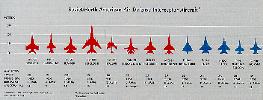 As a result of the Soviet air and air defense reorganization that occurred in the mid-1980s, many interceptor aircraft were resubordinated and returned
to the air defense forces. The Soviets deploy their newest and most sophisticated airborne surveillance and interceptor assets with these forces. For example, in the past year, the number of fourth-generation, look-down/shoot-down-capable aircraft, such as the MiG-31 Foxhound and Su-27 Flanker, has increased by
approximately 40 percent. While there are over 400 Foxhound and Flanker aircraft in the air defense force the total number of fourth-generation aircraft remains small relative to the force of over 2,000 interceptors. By 1994 one-half of the air defense inventory will be made up of fourth-generation aircraft, and by 1999 all will be fourth generation or later. The Soviet air defense forces also are continuing to deploy their Mainstay AWACS to enhance their detection and tracking capabilities. The Soviets probably have at least 10 of these aircraft now operational.
As a result of the Soviet air and air defense reorganization that occurred in the mid-1980s, many interceptor aircraft were resubordinated and returned
to the air defense forces. The Soviets deploy their newest and most sophisticated airborne surveillance and interceptor assets with these forces. For example, in the past year, the number of fourth-generation, look-down/shoot-down-capable aircraft, such as the MiG-31 Foxhound and Su-27 Flanker, has increased by
approximately 40 percent. While there are over 400 Foxhound and Flanker aircraft in the air defense force the total number of fourth-generation aircraft remains small relative to the force of over 2,000 interceptors. By 1994 one-half of the air defense inventory will be made up of fourth-generation aircraft, and by 1999 all will be fourth generation or later. The Soviet air defense forces also are continuing to deploy their Mainstay AWACS to enhance their detection and tracking capabilities. The Soviets probably have at least 10 of these aircraft now operational.
Command, Control, and Communications (C3)
The successful conduct of air defense operations depends, in part, on the speed and efficiency of C3 systems as well as the air defense radar's ability to acquire accurate air-surveillance data. Recent developments indicate the Soviets are extensively using computer assisted decision making equipment, to include air and air defense battle management systems. The air defense surveillance network is assisted by passive detection systems located on the country's periphery that enhance overall early-warning capability.
Radars
Over the past decade, the Soviets have improved the capabilities of their air defense radars. New phased array radars are better able to track and engage multiple air targets than their predecessors. Some new early warning radars are capable of determining range, azimuth, and elevation, thus eliminating the need for separate height-finder radars. Some previous low-altitude radar gaps also are being closed, making undetected penetration by low-flying aircraft more difficult. Such improvements became more urgent in the wake of the air defense debacle involving the intruding Cessna that landed in Red Square in 1987.
Since the early 1980s the Soviets have been upgrading the world's only operational ABM system, located around Moscow. The upgraded system probably will be partly operational this year, and will provide the Soviets, for the first time, with a two-layered defense of high-value targets in the Moscow area.
The components of the new Moscow ABM system include two interceptor missiles: a long-range modified Galosh ABM designed to engage ballistic missile RVs outside of the atmosphere; and the Gazelle, a shorter range, high-acceleration missile designed to engage RVs after they have reentered the earth's atmosphere. The ABM system also includes the new, large, multifunction Pillbox radar at Pushkino near Moscow. The radar provides 360-degree coverage against incoming missiles and is expected to become operational by 1990. This new system will allow the Soviets, for the first time, to engage ICBM and SLBM RVs accompanied by penetration aids, because the end atmospheric interceptor can engage the RV after most penetration aids are stripped off by the atmosphere. In addition, the new system apparently will comprise the full 100 launchers permitted by the ABM Treaty. The system, however, has major weaknesses. With only 100 interceptor missiles, the system can be saturated, and with only the single Pillbox radar at Pushkino providing support to these missiles, the system is highly vulnerable to suppression.
In the mid-1970s, the Soviets began building a network of large phased-array radars (LPARs). Currently, there are nine LPARs, in various stages of construction. The entire network is expected to become operational by the mid-1990s. When fully operational, this network will provide highly redundant coverage of the main attack corridors into the USSR. Most of this coverage will also be redundant with the coverage of the Hen House ballistic missile detection and tracking radars. In addition, the LPARs can track far more objects than the older Hen House radars while providing improved impact prediction accuracy.
In October 1987 the Soviets declared a one-year moratorium on construction at the Krasnoyarsk LPAR, a facility that, because of its location and orientation, clearly violates the ABM Treaty. In fact, while there was some activity at the radar site last year, there was no apparent construction or electronics installation activity on the radar structure itself. Although the original moratorium was scheduled to end in October 1988, the Soviets announced that it will remain in effect indefinitely. In addition, in his speech before the United Nations, General Secretary Gorbachev announced that the military had turned over the Krasnoyarsk LPAR to the USSR Academy of Sciences for space-related research, and he suggested that an international space organization under UN auspices might eventually operate it. However, because the facility could be turned back to the Soviet military in a short period of time, and function as a ballistic missile detection and tracking radar, the United States continues to maintain that the Krasnoyarsk violation can only be corrected by the dismantlement of the facility.
Since the 1960s, the Soviets have been conducting a substantial research program in advanced technologies for ballistic missile defense. General Secretary Gorbachev acknowledged this effort in November 1987:"The Soviet Union is doing all the United States is doing, and I guess we are engaged in research, basic research, which relates to these aspects which are covered by the SDI of the United States." Although the Soviet programs cover many of the same technologies being explored by the US SDI, they involve a much greater investment of plant space, capital and manpower.
The Soviet passive defense program is a major element in an integrated system of strategic defenses designed to lessen the effects of a nuclear attack. The principal objectives of the passive defense effort include: ensuring wartime leadership continuity; mobilizing the economy speedily and effectively; protecting the industrial base and essential work force; and developing a credible reconstitution capability. An extensive, redundant set of hardened command post and communications facilities and exurban relocation sites for all key echelons of command within the military and the Party-government apparatus constitutes the foundation of the Soviet passive defense program.
For decades the Soviet Union has had a comprehensive program under way to ensure leadership survival and continuity of function in the event of nuclear war. This effort has involved the construction of deep underground command posts, secret subway lines, and other facilities beneath Moscow, major Soviet cities, and the sites of key military commands. These deep underground facilities today are, in some cases, hundreds of meters deep and can accommodate thousands of people. Their sole function is to protect the senior Soviet leadership from direct nuclear attack. As nuclear arsenals on both sides have become larger and more potent, these facilities have been expanded and excavated to greater depths. In addition to deep underground facilities, the Soviets also have constructed near-surface bunkers and exurban relocation sites for military, Party, and government authorities, both in the Moscow area and throughout the Soviet Union. These would accommodate all key command and management staffs down to the local, territorial level in the Party-government hierarchy and the regimental-level in the Strategic Rocket Forces, Air Defense Forces, and Air Forces. The provision of leadership protection facilities for Party and state officials having no responsibilities for the conduct of military operations indicates that a major program goal is support of post-strike societal and economic reconstitution efforts.
The continued funding of improvements to the passive defense program indicates that it does not yet fully meet Soviet requirements. Nonetheless, the extensive preparations the Soviets have made give their leadership the potential to perform effectively in a nuclear war environment. The fact that the Soviets continue to build additional hardened command facilities and upgrade older ones suggests that the leadership continues to believe the program's benefits are well worth the cost.
Soviet planners use the term "radio-electronic combat" (REC) to refer to their integrated program to disrupt enemy military C3 at all levels. Embodied in the Soviet doctrine for REC is an integrated effort centered on reconnaissance, electronic countermeasures (jamming), physical attack (destruction), and deception operations. Each of these elements contributes to the disruption of effective command and control at a critical decision point in battle. The Soviets vigorously pursue REC measures at strategic, operational, and tactical levels. At the strategic level, the Soviet REC effort may involve simultaneous operations to deceive Western intelligence collection programs and to jam strategic C3.The Soviets are continuing to enhance their strategic REC mission capability.
Soviet attempts to counter enemy strategic command and control in wartime would involve disrupting the entire range of communication media available for strategic C3. Using their concept of Radiablokada(Radio Blockade), the Soviets would attempt to isolate entire geographic regions and prevent deployed forces from communicating with their higher headquarters.
While the Soviets have recently stopped their routine jamming of foreign radio broadcasts directed at Soviet audiences, high-frequency jamming antennas are still located in all major Soviet urban areas These civil broadcast antennas remain available for wartime or crisis use as a strategic countermeasure asset. The transmitter power and range capability of these systems make them suitable for employment against NATO high-frequency communications. The large number of high-power transmitters and long-range directional antennas under the Soviet Ministry of Communications constitutes an additional pool of strategic jamming assets. Used for the world-wide broadcast of such programs as Radio Moscow, these facilities could be employed effectively against U.S. and NATO high-frequency communications.
According to Soviet views on the nature of war, strategic defense operations are one of the basic forms of military action designed to repulse an enemy attack and limit its damage. While no single element of a layered defense need necessarily be highly effective, the Soviets seek to achieve defense with an overall significant effect through successive layers.
While the Soviets now insist that their doctrine is defensive, they have made no specific statements as to how this relates to their strategic defense programs. The scope and nature of their programs indicate the overall capability of Soviet strategic defense continues to increase substantially.
Glasnost has led to a variety of new public reports on the Soviet space program. These reports have been highly selective and continue to downplay the largely military orientation of Soviet space systems and operations. Most information released by the USSR in recent years continues to portray the Soviet space program as nonmilitary, while extolling advances in technology and promoting Soviet efforts to penetrate the market for commercial space services. The Soviets apparently have made no effort to change their military space objectives as they maintain they are doing with some of their other military forces. The Soviets seek sufficient supremacy to provide optimal space-based support for their terrestrial military forces and the capability to deny the use of space to other states.
 The Soviets currently operate about 50 types of space
systems, including numerous military satellites with missions such as reconnaissance and surveillance, launch detection and attack warning, support for strategic and tactical targeting, and the destruction of enemy spacecraft. Other satellites appear to have a variety of possible military-related missions, including radar elaboration, atmospheric density modeling, and spacecraft technology experimentation. Most of the remaining Soviet satellite systems have dual military-civilian use.
These include all manned and man-related spacecraft as well as communications, navigational, meteorological, earth resources, and radar arraying oceanographic satellites, and various other experimental or developmental payloads. By far the smallest category of Soviet satellites (about 5 percent) is assessed to be dedicated completely to civilian and/or scientific purposes. These include interplanetary probes and biological research, environmental, and materials processing (now called Foton) satellites.
The Soviets currently operate about 50 types of space
systems, including numerous military satellites with missions such as reconnaissance and surveillance, launch detection and attack warning, support for strategic and tactical targeting, and the destruction of enemy spacecraft. Other satellites appear to have a variety of possible military-related missions, including radar elaboration, atmospheric density modeling, and spacecraft technology experimentation. Most of the remaining Soviet satellite systems have dual military-civilian use.
These include all manned and man-related spacecraft as well as communications, navigational, meteorological, earth resources, and radar arraying oceanographic satellites, and various other experimental or developmental payloads. By far the smallest category of Soviet satellites (about 5 percent) is assessed to be dedicated completely to civilian and/or scientific purposes. These include interplanetary probes and biological research, environmental, and materials processing (now called Foton) satellites.
The Soviets continue to maintain and improve their operational satellite networks dedicated to the support of terrestrial military forces, but particular satellites are never discussed in a military-related context. The Soviets are providing more data on some categories of these satellites, often in their launch announcements or occasionally in other press reports. The information reported is usually accurate, but is almost always selective and incomplete, and is designed to portray Soviet space activity as peaceful and nonmilitary in nature. Recently, however, the Soviet leadership has acknowledged that military space programs "enhance the combat efficiency of our armed forces by 1.5-2 times."
 The Soviets generally attempt to present an unfavorable view of US military space activity, while emphasizing the peaceful and nonmilitary aspects of their space program. Yet, in fact, the Soviets provide dedicated military support from space. They possess and continue to operate unique space-based targeting systems that are designed to support combat operations. Satellites, such as the Radar Ocean and ELINT Ocean Reconnaissance Satellites (RORSAT and EORSAT), which are used to locate and target US and allied military forces, are clearly dedicated to support war fighting capabilities. The Soviets also have the world's largest and most responsive space launch infrastructure, including extensive booster and spacecraft production pipelines, which is optimized to support military operations. At the same time, their antisatellite capabilities allow the Soviets to deny or inhibit an enemy's use of vulnerable satellite systems. Such capabilities certainly reflect a military-oriented space program.
The Soviets generally attempt to present an unfavorable view of US military space activity, while emphasizing the peaceful and nonmilitary aspects of their space program. Yet, in fact, the Soviets provide dedicated military support from space. They possess and continue to operate unique space-based targeting systems that are designed to support combat operations. Satellites, such as the Radar Ocean and ELINT Ocean Reconnaissance Satellites (RORSAT and EORSAT), which are used to locate and target US and allied military forces, are clearly dedicated to support war fighting capabilities. The Soviets also have the world's largest and most responsive space launch infrastructure, including extensive booster and spacecraft production pipelines, which is optimized to support military operations. At the same time, their antisatellite capabilities allow the Soviets to deny or inhibit an enemy's use of vulnerable satellite systems. Such capabilities certainly reflect a military-oriented space program.
 The Soviets describe their Global Navigation Satellite System (GLONASS), for example, as a space navigation system for Soviet civil aviation planes, merchant vessels, and fishing boats. Obviously, Soviet military aircraft, ships, and other equipment will find considerable utility in such a navigational system. In a similar vein, Soviet announcements of communication, meteorological, and geodetic satellite launches describe their missions solely
in terms of providing support to the Soviet Union's national economy and the interests of science and international cooperation. They never acknowledge the fact that the Soviet military directly benefits from these satellites for command and control, weather forecasting and targeting purposes.
The Soviets describe their Global Navigation Satellite System (GLONASS), for example, as a space navigation system for Soviet civil aviation planes, merchant vessels, and fishing boats. Obviously, Soviet military aircraft, ships, and other equipment will find considerable utility in such a navigational system. In a similar vein, Soviet announcements of communication, meteorological, and geodetic satellite launches describe their missions solely
in terms of providing support to the Soviet Union's national economy and the interests of science and international cooperation. They never acknowledge the fact that the Soviet military directly benefits from these satellites for command and control, weather forecasting and targeting purposes.
 The Soviets recognize that their present ASAT capabilities are insufficient to deny completely the use of space to an opponent. Though they could physically attack, and possibly destroy, satellites in near-earth orbit,
the Soviets are probably limited to using nondestructive methods such as electronic warfare against satellites in high orbits. Since the 1960s, the USSR has been engaged in research to develop directed-energy weapons, some of which will be based in space.
The Soviets recognize that their present ASAT capabilities are insufficient to deny completely the use of space to an opponent. Though they could physically attack, and possibly destroy, satellites in near-earth orbit,
the Soviets are probably limited to using nondestructive methods such as electronic warfare against satellites in high orbits. Since the 1960s, the USSR has been engaged in research to develop directed-energy weapons, some of which will be based in space.
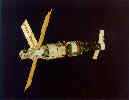 The Soviets continued their very successful manned space program during 1988, concluding 27 months of continuous manned presence in orbit in April 1989. While the Soviets publicly emphasized the cost-saving implications of this development, a more important factor was the technical problems they encountered with the expansion modules they plan to launch to the Mir space station. This hiatus in manned space activity, which reportedly will continue until the fall of
1989, represents a minor setback for the Soviet space station program. It must be emphasized, however, that the Soviets have made great progress in manned-space activity during the past several years.
The Soviets continued their very successful manned space program during 1988, concluding 27 months of continuous manned presence in orbit in April 1989. While the Soviets publicly emphasized the cost-saving implications of this development, a more important factor was the technical problems they encountered with the expansion modules they plan to launch to the Mir space station. This hiatus in manned space activity, which reportedly will continue until the fall of
1989, represents a minor setback for the Soviet space station program. It must be emphasized, however, that the Soviets have made great progress in manned-space activity during the past several years.
 The Soviets are heavily publicizing their space shuttle orbiter, the Buran, and its launch system, Energiya. The initial launch, flight, and return of Buran, conducted unmanned and entirely under automatic control on 15 November 1988, appeared successful. The demonstrated capability to conduct the mission unmanned, especially during landing, is an impressive technical achievement. When the shuttle system and the associated Energiya in the heavy-lift mode are fully operational, the Soviet Union will have a tremendous capacity
to assemble and maintain in orbit large spacecraft and space structures. The Soviets also will have greatly enhanced their ability to return large space station components, spacecraft, and significant amounts of materials to earth using their shuttle orbiter. In addition to space station support, the shuttle probably will serve as an alternate platform from which to conduct military and scientific research and development work.
The Soviets are heavily publicizing their space shuttle orbiter, the Buran, and its launch system, Energiya. The initial launch, flight, and return of Buran, conducted unmanned and entirely under automatic control on 15 November 1988, appeared successful. The demonstrated capability to conduct the mission unmanned, especially during landing, is an impressive technical achievement. When the shuttle system and the associated Energiya in the heavy-lift mode are fully operational, the Soviet Union will have a tremendous capacity
to assemble and maintain in orbit large spacecraft and space structures. The Soviets also will have greatly enhanced their ability to return large space station components, spacecraft, and significant amounts of materials to earth using their shuttle orbiter. In addition to space station support, the shuttle probably will serve as an alternate platform from which to conduct military and scientific research and development work.
 The Soviet capability to provide space-based support to its terrestrial military forces continues to improve and expand, as does its capability to place payloads in orbit. The Soviet capability to conduct ASAT and ABM operations continues to be unrivaled, while research and development of even more capable systems is occurring in Soviet facilities. Glasnost, however, has yet to address the many significant military aspects of the Soviet space program. Soviet denials that they use cosmonauts for military purposes and possess systems for waging war in space are equivalent to the Soviet contention prior to Gorbachev's admission in November 1987 that the USSR was not conducting SDI-like research. Such
discrepancies regarding Soviet military space programs and objectives leave their claims about a defensive military doctrine and reasonable sufficiency somewhat suspect.
The Soviet capability to provide space-based support to its terrestrial military forces continues to improve and expand, as does its capability to place payloads in orbit. The Soviet capability to conduct ASAT and ABM operations continues to be unrivaled, while research and development of even more capable systems is occurring in Soviet facilities. Glasnost, however, has yet to address the many significant military aspects of the Soviet space program. Soviet denials that they use cosmonauts for military purposes and possess systems for waging war in space are equivalent to the Soviet contention prior to Gorbachev's admission in November 1987 that the USSR was not conducting SDI-like research. Such
discrepancies regarding Soviet military space programs and objectives leave their claims about a defensive military doctrine and reasonable sufficiency somewhat suspect.
The Soviet doctrinal requirement for a strategic posture that deters a strategic nuclear strike against the Soviet Union while, at the same time, providing a Soviet strategic warfighting capability will likely remain. However, developments within the programs may not proceed at the same rate as in the past decade. For example, the Soviets will continue to improve the effectiveness of their strategic weapons and deploy large numbers of land-mobile systems, but they appear to be serious about reducing the size of the overall force through mutual agreements with the West. Such reductions are expected with reduced targeting requirements brought about by negotiated changes in Western forces. The Soviets have shown a similar willingness to make further reductions in shorter-range theater-nuclear weapons. In contrast, future developments in the Soviet defense and space forces, and in their passive defense programs, will probably show general continuity with past actions.